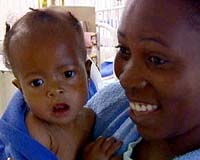| . |  |
. |
Johannesburg (AFP) Nov 23, 2010 Expanded access to AIDS treatment in sub-Saharan Africa has dramatically cut deaths from the disease, but the region remains the worst affected in the world, a UN report said Tuesday. Sub-Saharan Africa saw an estimated 320,000 fewer people die of HIV-related causes in 2009 than in 2004, when the region began to dramatically scale up access to anti-AIDS drugs, according to the United Nations AIDS agency's 2010 global report on the epidemic. "The efforts of anti-retroviral therapy are really evident, especially in our region of the world, sub-Saharan Africa, where because of access we have seen 20 percent fewer deaths related to HIV than in 2004," Sheila Tlou, UNAIDS regional director for sub-Saharan Africa, told journalists. But, she said, "Sub-Saharan Africa still bears the brunt of the epidemic, in that 68 percent of the people living with HIV are in our region." Eastern and southern Africa remain the epicenter of the epidemic and have a disproportionate number of HIV infections, UNAIDS found. "Eastern and southern Africa is only 5.4 percent of the global population, but more than 50 percent of people living with HIV are here," said Tlou. Across sub-Saharan Africa, 22.5 million people are living with HIV, more than any other region in the world, and 68 percent of the global total of 33.3 million people, UNAIDS found. The region's HIV-positive population has risen by 2.2 million since 2001, showing that Africa still faces a difficult battle to control AIDS. But the report found signs of success in the continent's fight against the disease. In 2009, there were 1.8 million new HIV infections in sub-Saharan Africa, down from 2.2 million in 2001 -- a drop of more than 18 percent. And of the 33 countries worldwide that saw new HIV infections fall by more than 25 percent between 2001 and 2009, 22 are in sub-Saharan Africa. "The largest epidemics in sub-Saharan Africa -- Ethiopia, Nigeria, South Africa, Zambia, and Zimbabwe -- have either stabilized or are showing signs of decline," UNAIDS said. "Between 2000 and 2008, the rate of new HIV infections among young people declined by more than 25 percent in 15 most-affected countries in sub-Saharan Africa." UNAIDS said South Africa continues to have the largest AIDS epidemic in the world, with 5.6 million HIV-positive people. Neighbouring Swaziland has the highest adult infection rate, 25.9 percent. Across sub-Saharan Africa, women and girls are disproportionately affected by HIV, the agency said -- 76 percent of all HIV-positive women in the world live in the region. Tlou said despite bright spots in the UN report, sub-Saharan Africa must continue to step up its response to the epidemic. She called on the region's governments to increase funding and "rely less on international donors". "The AIDS response is fragile," she said. "It needs to be kept alive through funding."
Share This Article With Planet Earth
Related Links Epidemics on Earth - Bird Flu, HIV/AIDS, Ebola
 New AIDS cases fall by one fifth in a decade: UN
New AIDS cases fall by one fifth in a decade: UNGeneva (AFP) Nov 23, 2010 The number of new cases of HIV/AIDS has dropped by about one-fifth over the past decade but millions of people are still missing out on major progress in prevention and treatment, the UN said Tuesday. In 2009, 2.6 million people contracted the HIV virus that causes AIDS, down 19 percent from the 3.1 million recorded in 2001, said UNAIDS, the UN agency spearheading the international campaign ... read more |
|
| The content herein, unless otherwise known to be public domain, are Copyright 1995-2010 - SpaceDaily. AFP and UPI Wire Stories are copyright Agence France-Presse and United Press International. ESA Portal Reports are copyright European Space Agency. All NASA sourced material is public domain. Additional copyrights may apply in whole or part to other bona fide parties. Advertising does not imply endorsement,agreement or approval of any opinions, statements or information provided by SpaceDaily on any Web page published or hosted by SpaceDaily. Privacy Statement |